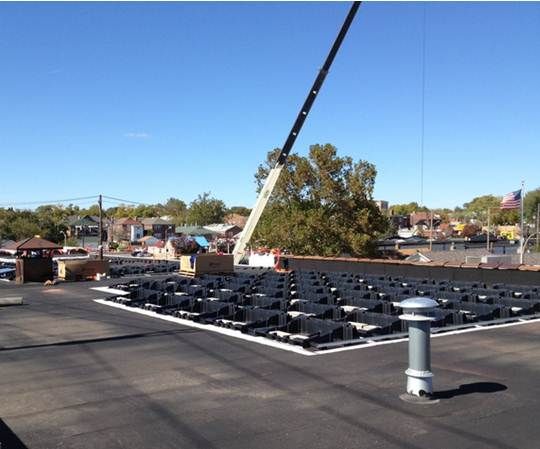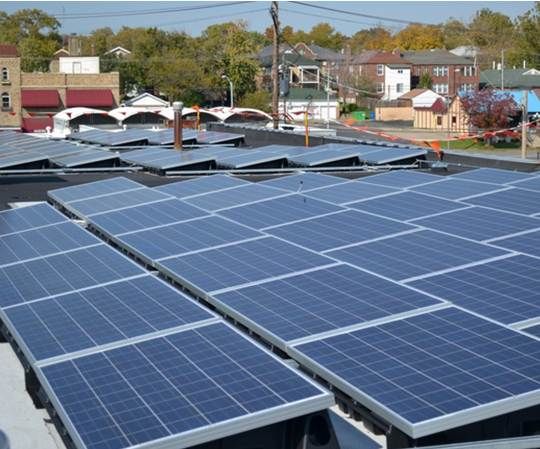There are two remarkable things about the 25-kilowatt solar system just completed by Frederic Roofing. The first is how unremarkable the 84-year-old roofing company’s first solar installation was and the second is where the company will build its second system.
“Probably the hardest part of the job was getting everything up on the roof,” VP Gene Frederic said of the installation on the AJ Adhesives distribution warehouse. “Once that was done, it wasn’t that big a deal.”
AJ Adhesives requested Lightway solar panels. St. Louis solar developer Clean Power Design selected Renusol America’s ballasted non-penetrating racking and Fronius inverters.
Before the first installation was complete, the roofer contracted to install almost the same system, using Sharp panels, on its own headquarters.
“We kicked around the idea of getting into solar for three or four years,” Frederic said. “The utility rebates were there, but what they were getting paid and what they were paying didn’t make sense” -- especially because of Missouri's low-priced, coal-generated electricity. “Now that the price of panels and racking has gone down, it makes sense.”

Both AJ Adhesives and Frederic Roofing will get a $2.00-per-watt rebate from Ameren Missouri (NYSE:AEE) and will max out the 25-kilowatt limit for their flat-roof systems, Frederic said.
“That is the next wave in our industry,” said Clean Power Design founder Jason Loyet. “Frederic Roofing has built thousands of roofs. It is now going up the solar learning curve. We are now doing a project on their headquarters. In Tennessee, we have done projects across the state and our first wave was installs on contractors’ roofs.”
Loyet has been in solar in the Midwest and the Mid-South since a 2005. “I saw an opportunity in the solar industry in focusing on the last mile of solar development, in distribution, and on empowering local electrical contractors and roofers to be the solar installers of the future.”
Those contractors in Tennessee, Loyet said “have gone way up the learning curve. They now have experience at installation and at servicing inverters and seeing what a solar system’s production is on their own property.”
Solar, Loyet said, “is a natural fit for roofing and electrical contractors. It is not far outside what they already do. Now they are putting the pieces together. That is what the next wave is.”
Sun is not a problem in the Midwest, Loyet said. “The DOE maps show there is as much insolation in Missouri as in parts of Florida. Look at the Midwest compared to Germany. In Illinois, people ask if solar will work there. One answer we give is, ‘Look how tall the corn grows.’ There is an enormous amount of sun in the Midwest. "
The challenge, Loyet said, is that “we are coal-reliant states. We are competing with coal and very low electricity rates.”
Those low rates have also prevented third-party ownership (TPO) programs like those operated by Sunrun, SolarCity and Clean Power Finance from growing. “Those programs have matured where the cost per kilowatt-hour is higher than in the Midwest,” Loyet said. “Power may be eight to ten cents in the Midwest and sixteen to twenty cents in California.”
But, Loyet said, the Midwest will likely see the highest electricity price inflation in the U.S. "You are already seeing year-on-year double-digit electric inflation. That is where solar is going to make an impact. It will level out the cost of energy and offer a locked-in price.”
A recent report documenting state-by-state delivered costs of coal from advocacy group Clean Energy Action showed significant inflation over the last eight years. As examples, Missouri went from $0.92 per MMBTU in 2004 to $1.72 per MMBTU in 2011, Illinois went from $1.16 to $2.01, Arkansas went from $1.23 to $1.91, and Tennessee went from $1.33 to $2.82.
“It used to be,” Loyet said, “that if you put 3.5 percent inflation in front of a conservative CFO, he would balk. Not anymore. The shift has taken less than five years. People accept that the next twenty years of energy is not going to look anything like the last twenty years.”

Loyet talked about two inter-related challenges to Midwest solar growth. First, he said, “is the learning curve. It is still an early market. There are not a lot of pure-play solar companies.” Second, he said, “there are not a lot of incentives and utility programs. So there hasn’t been an uprising of solar installers at the grassroots level who can go out and educate the market.”
The way forward, he said, “is electrical contractors and roofers.” They know the markets and don’t yet have competition from pure-play solar companies. “You will have more electrical contractors and roofers offer solar as a service under their umbrella. They have every tool in their tool belt. Together, they have the core competency to compete.”
A lot of contractors have learned solar working as sub-contractors to pure-play solar companies, Loyet said. They are ready to go out and educate the market, do the marketing and sell systems.
“What you are seeing with Frederic Roofing is the future. There are thousands of roofing contractors and electrical contractors across the nation taking this first step. That is how we are going to build out the next generation of power.”



